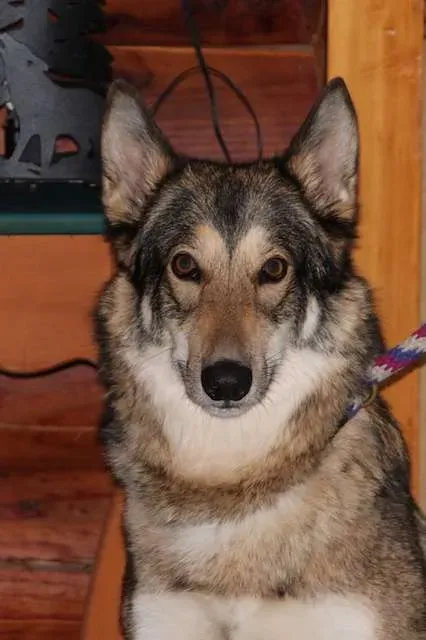Wolfdog hybrids captivate with their wild allure and striking features, but they often face profound struggles in human homes. These unique animals, blends of wolves and domestic dogs—sometimes with coyote influence—embody a tragic mismatch between primal instincts and modern pet ownership. During a visit to Grey Wolf Central Wisconsin Rescue, I met Bits, a gorgeous wolfdog who’s been terrified of strangers yet found sanctuary there for two years. His story, and those of others, highlights why wolfdog hybrids demand careful consideration before anyone contemplates ownership. As pet care experts emphasize, understanding their needs is crucial for any dog lover exploring exotic breeds.
Meeting Bits: A Glimpse into Wolfdog Rescue Life
At Grey Wolf Rescue, run by dedicated caretakers Jayne and Mike Belskey, wolfdog hybrids receive the specialized care they desperately need. Bits arrived as a panicked, huddled mess from a shelter, but with patient handling, he began to relax—even lying down near a visitor after hours of gentle interaction techniques like avoiding eye contact, yawning, and speaking softly. This progress speaks volumes about the trust-building required for wolfdogs, far beyond typical dog training.
Wolfdog care differs starkly from standard canine routines. These hybrids inherit wolves’ high energy, independence, and wariness of humans, making socialization a marathon, not a sprint. Veterinary visits, like the annual check-up I witnessed, add stress; leashes and muzzles ensure safety during vaccinations and blood tests for tick-borne diseases.
 Bits the wolfdog hybrid relaxing cautiously near a visitor
Bits the wolfdog hybrid relaxing cautiously near a visitor
Bits’ direct gaze during his exam conveyed a mix of vulnerability and intensity—a poignant reminder of their expressive yet guarded nature. Rescues like Grey Wolf provide enclosures mimicking natural habitats, allowing wolfdogs to roam in secure, spacious areas rather than cramped yards.
Personal Encounters with Young Wolfdog Hybrids
My consulting experience with wolfdog hybrids reveals their adolescent challenges. One four-month-old, reportedly 75% wolf, dazzled with intelligence and energy in an apartment setting. She scaled furniture, chewed belongings, urinated indoors, and shredded blinds in endless cycles—behaviors unstoppable like a waterfall. Despite interventions, her owners, unprepared for such vigor, couldn’t cope. Breeders refused returns, and rescues were overwhelmed, underscoring the abandonment crisis in wolfdog ownership.
Another six-month-old hybrid bit firmly during a possession aggression test, locking eyes with a clear “Don’t do that again” message. Swapping his toy for chicken backfired spectacularly, leading to his euthanasia after biting his owner. These cases illustrate wolfdogs’ strong predatory drives and lack of deference to humans, unlike domestic dogs bred for companionship.
Wolfdog hybrids demand vast spaces for daily miles of trotting, mental stimulation, and pack dynamics. They view humans as equals, not leaders, complicating training. Resources like Patricia McConnell’s blog and Ceiridwen Terrill’s Part Wild detail these realities, drawing from real-world observations.
Why Wolfdogs Don’t Thrive as Pets: Expert Insights
Wolfdogs occupy a limbo—they can’t survive in the wild due to lost instincts and can’t fully adapt to homes. Jayne Belskey, who’s devoted her life to wolfdog rescue since 1999, shares: “They don’t fit in our domestic world… doomed to life at the end of a chain or stressing in a small pen.” Starting unintentionally with one pup, she’s built a network aiding countless hybrids from negligent owners.
Breeding wolves to dogs floods rescues with suffering animals. Ethical concerns abound: captive wildlife contradicts wolves’ free-roaming essence. While some wolfdogs bond deeply with prepared owners, the majority face heartbreak. Belskey notes enclosures fill instantly, highlighting the placement crisis.
Veterinary expertise reinforces this. Dr. Pam Prochaska’s gentle exams at Grey Wolf prioritize minimal stress, muzzling for safety during quick procedures.
 Wolfdog Flint receiving veterinary care with muzzle for safety at Grey Wolf Rescue
Wolfdog Flint receiving veterinary care with muzzle for safety at Grey Wolf Rescue
Organizations like the AVMA (American Veterinary Medical Association) warn against hybrid breeding, citing health risks like genetic issues and behavioral unpredictability. For pet owners, sticking to purebred or mixed domestic dogs ensures better matches.
The Lifesaving Work at Grey Wolf Rescue
Jayne and Mike’s facility houses wolfdog pairs in massive, secure enclosures—a feat of engineering and commitment. They forgo vacations, providing round-the-clock care to traumatized animals. Donations sustain this vital work; visits are limited to protect the shy hybrids.
This model exemplifies responsible wolfdog care: prioritizing welfare over novelty. Prospective owners must research extensively, perhaps volunteering at rescues first.
In contrast to farm life woes—like a dog’s injury recovery or backyard renovations—Grey Wolf’s focus remains unwavering.
 A fawn spotted en route to Grey Wolf Rescue, symbolizing wild beauty
A fawn spotted en route to Grey Wolf Rescue, symbolizing wild beauty
Final Thoughts on Wolfdog Hybrids
Wolfdog hybrids mesmerize with ethereal beauty but suffer from mismatched lifestyles, fueling rescues and ethical debates. Stories like Bits’ recovery affirm dedicated care’s impact, yet breeding must cease to prevent floods of displaced animals. Consult vets and experts before exotic pursuits; domestic dogs offer joy without the tragedy.
Support rescues like Grey Wolf Central Wisconsin Rescue. Share your local wolfdog experiences in comments, and explore more pet care guides on dog socialization and breed selection.
References
- Patricia McConnell’s Blog: Original Post on Wolfdogs
- Part Wild by Ceiridwen Terrill (Scribner, 2012)
- American Veterinary Medical Association guidelines on wolf hybrids
- Grey Wolf Central Wisconsin Rescue: thegreywolf.org
 Backyard construction disrupting native plants during home improvements
Backyard construction disrupting native plants during home improvements
